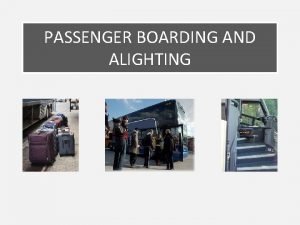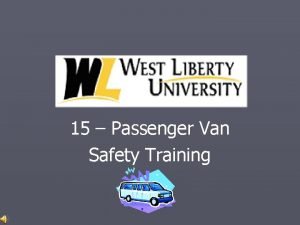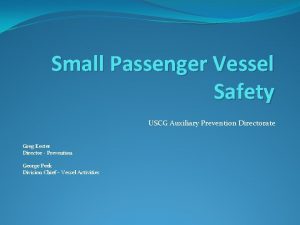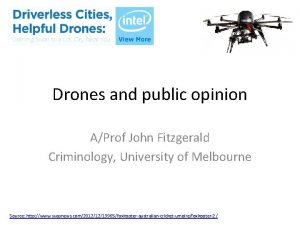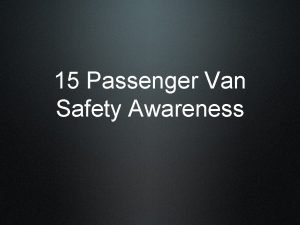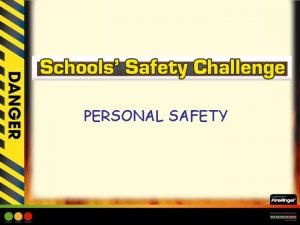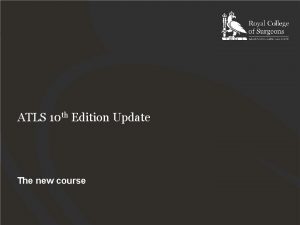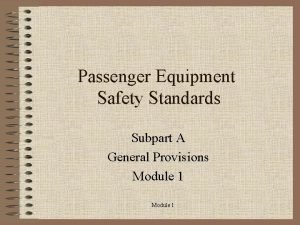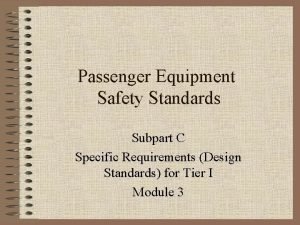Passenger Equipment Safety Standards Scenarios and Answers Module










- Slides: 10

Passenger Equipment Safety Standards Scenarios and Answers Module 1

Scenario 1 Conductor Brown, who is a qualified person (QP), is called to operate commuter train 242. The train has one four-axle locomotive weighing 180, 000 pounds and nine four-axle passenger cars, all equipped with tread braking units (TBU’s). After receiving a Class 1 A Brake Test, train 242 departs the station with passengers. The train operates eastward at maximum authorized speed. At mile post 15, the train strikes debris and the train brakes apply in emergency. Conductor Brown inspects the train and discovers damage to the service portion on two cars, and a hand brake fulcrum damaged on a third car. The damage is so severe that it causes the service portion to leak on both cars. Conductor Brown cuts out the air brakes system on both cars with damaged service portions which stops the air from leaking to atmosphere. He also disconnects the hand brake on the third car. Using this information compute the percentage of operative brakes remaining on train 242. Module 1

Scenario 1 Answer Train would have 80 % operative brake, 40 Axles, 8 axles cut out = 80 %. Divide the number of axles with operative brakes by total number of axles on train. (32 / 40 = 80%). Handbrakes are not to be considered when computing operative brakes. Module 1

Scenario 1 A Using the information provided in Scenario 1, one of the cars with a defective service portion has other defects which require that it be set out of the train. Now compute the percentage of operative brakes on train 242. Module 1

Scenario 1 A Answer Train would now have 88. 9 % or 89% effective brakes (36 Axles, 4 axles cut out = 88. 8 %). Divide the number of axles with operative brakes by total number of axles on train. (32 / 36 = 88. 9%) Module 1

Scenario 2 Using the percentage of operative brakes computed in Scenario 1, determine operating restrictions that must be placed on train for movement in compliance with Federal Regulations found in CFR 49 238. 15. Do the same for Scenario 1 A. Module 1

Scenario 2 Answer Scenario 1: 75 -84% operative brakes; üReduce speed by half or 40 mph (lesser) üMoved to next forward location where repair can be made üIf passenger safety is at risk, move the train to the next forward passenger station where passengers can be safely unloaded üAfter passengers discharged, moved to nearest location for repair Module 1

Scenario 2 Answer Continued Scenario 1 A: 85 -99 % operative brakes; üMoved to next forward location where repair can be made üIf passenger safety is at risk, move the train to the next forward passenger station where passengers can be safely unloaded üAfter passengers discharged, moved to nearest location for repair Module 1

Scenario 3 A QMP performing a Calendar Day Inspection of passenger cars in an outlying yard discovers a running gear defect on passenger coach number 5000. He determines that the coach must be moved to a central repair facility located 50 miles away. The coach must not be moved in passenger service and must be moved in a non-revenue train. Federal Regulations require that the defective equipment must be tagged or tracked in an automated tracking system prior to movement. List the information required on the tag, card, or in the automated tracking system. Module 1

Scenario 3 Answer • • • Reporting mark and car/locomotive number Name of railroad Name of inspector Location Date Defect(s) Movement/safety restrictions Destination Signature (if possible) /job title/location Module 1
 Boarding or alighting
Boarding or alighting 15-passenger van training exam answers
15-passenger van training exam answers Passenger vessel safety act of 1993
Passenger vessel safety act of 1993 Prof john fitzgerald
Prof john fitzgerald 15 passenger van safety training
15 passenger van safety training Hse culture ladder
Hse culture ladder Questions and answers for food safety
Questions and answers for food safety Personal safety scenarios
Personal safety scenarios Atls triage scenarios answers 10th edition
Atls triage scenarios answers 10th edition Dodo passenger pigeon and stellers
Dodo passenger pigeon and stellers Poem about impulse and momentum
Poem about impulse and momentum
